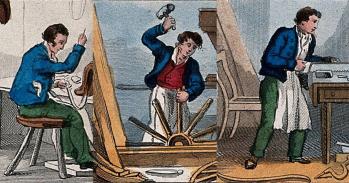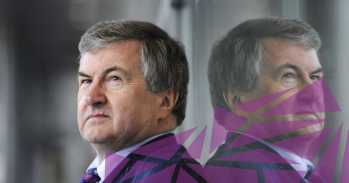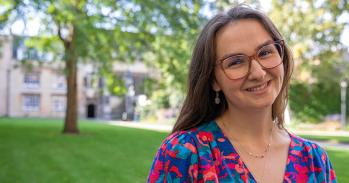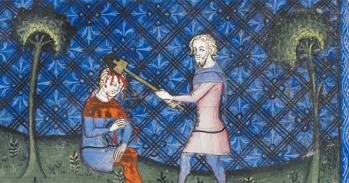Correspondence from young men caught up in the ravages of the First World War will be on display to the public for the first time at Christ's College as part of Open Cambridge on 9 and 10 September.
Correspondence from young men caught up in the ravages of the First World War will be on display to the public for the first time at Christ's College as part of Open Cambridge on 9 and 10 September.
... we are occupying the ‘Daily Mail’ trenches, which they show to the King, and all the big people who come out, because they are perfectly safe and absolutely unlike any other trench that has ever existed.
Robert Devereux
A letter written exactly 96 years ago by a young British solider serving in Gallipoli is among an archive of correspondence from men caught up in the First World War that will be on show to the public for the first time during Open Cambridge, when the Bodley Library of Christ’s College opens its doors on 9 and 10 September.
The letters displayed have been chosen from a total of around 30 sent by old boys of the Perse School in Cambridge to their headmaster WHD Rouse, who was a Fellow of Christ’s. On his death in 1950, he left archives of correspondence and working papers, as well of his library of books, to the College. Written by men as young as 18, serving in the armed forces throughout Europe and beyond, the letters reveal a sense of trust and optimism that in retrospect appears tragically naive.
On 6 September 1915, Geoffrey Claye, a lieutenant in the 7th Cheshire Regiment, wrote from Gallipoli: “At present we are out of the trenches & we are in a rest camp down by the sea. It is a most peaceful spot except when the Turks take to shelling us. I & the other officers of my company have a comfortable little dug out on the side of a sandy cliff.” He adds: "The food is splendid under the circumstances." Less than two years after writing these words on the shores of the Aegean, Claye was dead as the result of wounds sustained in the First Battle of Gaza. He was just 23 years old.
The First World War correspondence forms part of an exhibition called Christ’s at War. It also features the undergraduate who was the inspiration for the much-loved War Memorial that stands on Hills Road in Cambridge, and a section of a hut modelled on a building funded by the College to provide respite behind the front lines at Ypres in Belgium.
Famously eccentric, Rouse was a classicist who pioneered the “direct method” of teaching classics with Latin and Greek spoken in the classroom. He also ran the Officers Training Corps (OTC) at the Perse. Remarkably, he kept up a correspondence with many of his former pupils when they enlisted. In a testament of their loyalty, some wrote to him from the trenches and others from the decks of minesweepers.
A letter from another Perse School old boy offers a glimpse into the misleading representations of trench life by the British press at the time. Robert Devereux writes: “There is nothing very much doing here just now. We are in about the quietest part of the line, and we are occupying the ‘Daily Mail’ trenches, which they show to the King, and all the big people who come out, because they are perfectly safe and absolutely unlike any other trench that has ever existed.”
Christ’s at War was curated by Christ’s College Graduate Trainee Librarian, Charlotte Byrne. “As part of my traineeship I had the chance to put together an exhibition using the special collections in the library,” she said. “I am fascinated by early 20th-century history so I was very excited when I came across the Perse boys’ letters. I wanted to find out more about their authors and then I started to wonder about how Christ’s College was affected by the War.”
Another part of the exhibition focuses on the story of the Memorial to the First World War that stands at the junction of Station Road and Hills Road in Cambridge. It is a statue of a young man in uniform striding in the direction of the town while looking back towards the station, as if remembering the colleagues who were never coming home. Titled ‘The Homecoming’, the statue was designed to represent victory and to honour all of the Cambridgeshire men who had served in the war.
The statue is the work of the Canadian sculptor Tait Mackenzie, who was also responsible for Edinburgh War Memorial. Tait was commissioned for the project in 1920. While staying with the Master of Christ’s College, Tait spotted an undergraduate called Kenneth Hamilton and, impressed by his looks, used him as the model for the Cambridge War Memorial.
Cambridge War Memorial was unveiled in 1922. In the early 1980s moves to re-site the memorial in Market Square in the town centre were quashed. Recent plans to move it to a more accessible location adjacent to its current position in the centre of a busy intersection have now been approved.
During the First World War the YMCA (Young Men’s Christian Association) built huts on the Western front to provide soldiers with somewhere to socialise, relax and write letters. Christ’s College raised £700 to sponsor one of these huts.
The building funded by Christ’s was destroyed by the Germans in 1918 but a plaque with the college coat of alms was rescued by a Christ’s student called FHA Hendry. It is displayed inside a reconstruction of a section of the hut built for the exhibition by Christ’s carpenter, Martin Tuck.
Byrne hopes that the exhibition will show people how the Great War affected the lives of the young men of Cambridge.
Christ’s College Bodley Library will be open to the public on 9 and 10 September. The Christ’s at War exhibition is open on a drop-in basis but many of the other Open Cambridge events require booking.
For details and a full programme of all Open Cambridge events, talks and tours go to /opencambridge/ or phone 01223 766766.
This work is licensed under a Creative Commons Licence. If you use this content on your site please link back to this page.





